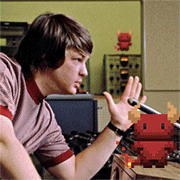|
GreenNight posted:The majority of the new HP laptops don't have an ethernet port either. They give you a dongle that connects to the laptops docking station port. Hell, the HP event I went to last month, their thinnest laptops don't even have a docking station port, they were pushing wireless docks. This will do: 
|
|
|
|

|
| # ? Apr 23, 2024 13:53 |
|
I bought the TB->GbE adapter for my macbook because I thought I needed it. I think I've used it twice in three years. 
|
|
|
|
Back in 1999, when I got my first real adult job as a newspaper copy editor, the paper I went to was still using its custom network of 386s for page layout and 286s for writing/editing. The 286s were cute little things that we were told never to turn off (and they almost never needed rebooting). When we rearranged the furniture and had to unplug everything, two of those 286s never woke up again. On the 386s, we used a page design system that involved a copper-coil mouse on a tablet. When you started the computer, the first thing you did was align the cross-hairs of the mouse over the matching cross-hairs on the tablet. Then you could almost, almost use it like a regular mouse. Remember this was 1999. I had a Pentium II at home and I was coming from a college paper that used Quark 3 on Power Macs. But this system had cost millions back when it was new, and the paper was reluctant to upgrade. They finally had to, though - the old system couldn't handle dates past 1999, and so everything had to be upgraded for Y2K so that everyone's newspaper would have the right dates on the page corners. I would love it if anyone else knows anything more about the system we used and those copper-coil mouse tablets. Google has turned up nothing. All I remember from the ~6 months I used it is that it involved typing a lot of code that looked a bit like HTML, and that there was something called "quad left" and something called "format merge."
|
|
|
|
pookel posted:Back in 1999, when I got my first real adult job as a newspaper copy editor, the paper I went to was still using its custom network of 386s for page layout and 286s for writing/editing. The 286s were cute little things that we were told never to turn off (and they almost never needed rebooting). When we rearranged the furniture and had to unplug everything, two of those 286s never woke up again. On the 386s, we used a page design system that involved a copper-coil mouse on a tablet. When you started the computer, the first thing you did was align the cross-hairs of the mouse over the matching cross-hairs on the tablet. Then you could almost, almost use it like a regular mouse. Remember this was 1999. I had a Pentium II at home and I was coming from a college paper that used Quark 3 on Power Macs. But this system had cost millions back when it was new, and the paper was reluctant to upgrade. They finally had to, though - the old system couldn't handle dates past 1999, and so everything had to be upgraded for Y2K so that everyone's newspaper would have the right dates on the page corners. I sort of remember seeing an old computer system in something that had a mouse that only worked with it's special tablet, but can't find any info. Same bit of media also showcased light pens.
|
|
|
|
pookel posted:I would love it if anyone else knows anything more about the system we used and those copper-coil mouse tablets. Google has turned up nothing. All I remember from the ~6 months I used it is that it involved typing a lot of code that looked a bit like HTML, and that there was something called "quad left" and something called "format merge." As for the page layout software...Adoble PageMaker? It was one of the major competitors to QuarkXPress before InDesign.
|
|
|
|
pookel posted:Back in 1999, when I got my first real adult job as a newspaper copy editor, the paper I went to was still using its custom network of 386s for page layout and 286s for writing/editing. The 286s were cute little things that we were told never to turn off (and they almost never needed rebooting). When we rearranged the furniture and had to unplug everything, two of those 286s never woke up again. On the 386s, we used a page design system that involved a copper-coil mouse on a tablet. When you started the computer, the first thing you did was align the cross-hairs of the mouse over the matching cross-hairs on the tablet. Then you could almost, almost use it like a regular mouse. Remember this was 1999. I had a Pentium II at home and I was coming from a college paper that used Quark 3 on Power Macs. But this system had cost millions back when it was new, and the paper was reluctant to upgrade. They finally had to, though - the old system couldn't handle dates past 1999, and so everything had to be upgraded for Y2K so that everyone's newspaper would have the right dates on the page corners. Sounds like one of the early typesetting software that ran on mini-computers. http://simple.wikipedia.org/wiki/Typesetting quote:Early minicomputer-based typesetting software was introduced in the 1970s and early 1980s, such as Datalogics Pager, Penta, Miles 33, Xyvision, troff from Bell Labs, and IBM's SCRIPT product with CRT terminals. Those replaced the electro-mechanical devices and used text markup languages to describe type and other page-formatting information. The descendants of these text markup languages include SGML, XML and HTML. Can't say that I've ever heard of a mouse that didn't use a ball or a laser There was one that needed a special mousemat to work as it had lines engraved on it. It was metal and would only work one way round - twist it 90' and it wouldn't register. That was early 1990's? tech. EDIT: any of these packages look familar? https://books.google.co.uk/books?id...omputer&f=false spog has a new favorite as of 22:25 on Jun 10, 2015 |
|
|
|
OK, I googled some more with different terms and came up with the answer: it was the Harris Pagination System with NewsMaker editing software. Couldn't find any actual photos, but I did find this: http://scholarworks.rit.edu/cgi/viewcontent.cgi?article=4799&context=theses It's a thesis on the manual for Harris operation, and if you scroll down to page 87, you can see a sketch of the "mouse" and a description. The dark circle around the crosshairs was copper, and the four diamond-shaped buttons were different colors and had different functions.  ETA: spog posted:
None of those match, but thanks for the link - that is really cool to read. I miss working with the old guys who could still tell stories about the hot metal days. pookel has a new favorite as of 22:30 on Jun 10, 2015 |
|
|
|
spog posted:There was one that needed a special mousemat to work as it had lines engraved on it. It was metal and would only work one way round - twist it 90' and it wouldn't register. That was early 1990's? tech. That sounds like the old optical mouse that came with SGI workstations. When I was in college I used to maintain a mol-bio research lab network at U of Iowa. One of the machines was an SGI Indigo used to model proteins and it had that kind of mouse. You had to calibrate every so often, but it was super accurate.
|
|
|
|
pookel posted:OK, I googled some more with different terms and came up with the answer: it was the Harris Pagination System with NewsMaker editing software. Couldn't find any actual photos, but I did find this: hah! I found one of these mice in a dusty office here once. I assumed it was an old CAD tool for drawing sets
|
|
|
|
pookel posted:OK, I googled some more with different terms and came up with the answer: it was the Harris Pagination System with NewsMaker editing software. Couldn't find any actual photos, but I did find this: flosofl posted:That sounds like the old optical mouse that came with SGI workstations. When I was in college I used to maintain a mol-bio research lab network at U of Iowa. One of the machines was an SGI Indigo used to model proteins and it had that kind of mouse. You had to calibrate every so often, but it was super accurate.
|
|
|
|
SubG posted:Yeah, that's a what's commonly called a puck. The surface it works on is called a digitizer. Type those two search terms into google and you'll get a whole shitload of similar devices.
|
|
|
|
Omnishambles posted:I'm not so surprised that someone put out an 8-track. I'm more baffled that there's a place that could still manufacture 8-tracks. Even on a small scale. And it retailed for $30. I don't know how many were made, but they rarely show up on ebay (there's one there now).
|
|
|
|
pookel posted:Cool, thank you. The Harris documentation insists on calling it a mouse, probably because real mice were a thing by then and they wanted to sound forward-thinking. So I always thought of it that way.  I guess in 1986 that poo poo wasn't as cut in stone as it would be soon after.
|
|
|
|
Collateral Damage posted:I bought the TB->GbE adapter for my macbook because I thought I needed it. I think I've used it twice in three years.
|
|
|
|
The postage meter at my workplace qualifies both as obsolete and a failure. It looks like it was built in the '90s with one of those awful ghosting dark-on-grreen LCDs with only two lines of 5x7 text, which of course means it doesn't really have any "user interface" worthy of the name. When it runs out of postage you have to let it dial the postage company, and I'm guessing it has like a 2400 baud modem or something because it takes loving forever, and then it usually has to do a "system update" that takes upwards of 10 minutes, and then it has to do a rates update, which takes a few more minutes, by which point I end up wishing they'd just give me a book of stamps instead. And then sometimes it will do a system update when you wanted to buy postage, but it won't actually buy any postage, so you have to buy postage again. And sometimes it will have a "data center error" and abort. All of these things happened to me today. I want to flog its designer to death with the meter's serial cable. Yes, it has one.
|
|
|
|
At my work we sell receipt-based Xbox Live codes that are generated from some dial-up thing. It takes about 2 mins to print off a code, and heaven forbid if somebody tries to ring you or you accidentally use it while a coworker is on the phone. Just the most godawful screeching. Then it causes the code generation to fail and you have to do it all again anyway. Plus, while processing trades, you can't use the mouse. If you do, it crashes both register computers and the POS system. Everything has to be rebooted and the tills reopened, a process that takes around 10 minutes. Hope the store isn't busy!
|
|
|
|
Flipperwaldt posted:My first computer was an Amstrad IBM PC compatible that referred to the mouse in the documentation as 'the turtle' That reminds me of the piece of obsolete technology I took with me to university - the Amstrad PPC 512 - a portable XT PC without a hard drive, just a couple of floppies, that ran off C cells. Given I went to uni in 1993, it was a bit elderly even then, but it was fine for some basic programming/maths work and writing papers.
|
|
|
|
Flipperwaldt posted:My first computer was an Amstrad IBM PC compatible that referred to the mouse in the documentation as 'the turtle' Oh god drat it now I'm nostalgic for LOGO. So many memories of amazing my teachers (who were untrained on the software) that REPEAT 360 FWD 1 RT 1 or drew a circle.
|
|
|
|
Working in media you get a nice dose of things that go obsolete within decades. Today's joy was being told that "hey we shot everything on Professional Disc, for archiving!  " "The cost of buying a reader is $3,695.00. And you know it's bad when the National Sound and Film Archive doesn't have one.
|
|
|
|
Kugyou no Tenshi posted:Oh god drat it now I'm nostalgic for LOGO. So many memories of amazing my teachers (who were untrained on the software) that REPEAT 360 FWD 1 RT 1 or drew a circle. LOGO. That was the next big thing when I was in grade school. We had entire classes devoted to learning LOGO. We were LOGO badasses, convinced we were going to make millions of dollars a year after school because we could blast out some killer 2D shapes with a couple commands. We were dumb.
|
|
|
|
Are Microsoft BASIC and Commodore BASIC the same? I know they are similar. My mom got a book of science activities for my kid that was printed in 1990, and it includes a program you can type in, written in Microsoft BASIC. He already has a C64 emulator since he saw me using one. Speaking of which, I skipped Steam last night in favor of Gateway to Apshai.
|
|
|
|
WebDog posted:"hey we shot everything on Professional Disc, for archiving!  And I thought I had it rough last month when a co-worker gave me his raw voice tracks on MiniDisc.
|
|
|
|
pookel posted:Are Microsoft BASIC and Commodore BASIC the same? I know they are similar. My mom got a book of science activities for my kid that was printed in 1990, and it includes a program you can type in, written in Microsoft BASIC. He already has a C64 emulator since he saw me using one.
|
|
|
|
WebDog posted:Working in media you get a nice dose of things that go obsolete within decades. Today's joy was being told that "hey we shot everything on Professional Disc, for archiving! Yet another Sony-designed media format doomed to failure. How many is it now? Betamax, DAT, Minidisc, ATRAC, MemoryStick, UMD, PFD, any more? KozmoNaut has a new favorite as of 14:19 on Jun 11, 2015 |
|
|
|
At least MemoryStick is just a flash storage medium, you can get a gazillion-in-1 card reader that'll have a slot for it for like  UMD... I like the sound of the drive spinning up because it reminds me of the Dreamcast? Nah everything still ran better off the cheap memory stick adapter that took two microSD cards, once I finished copying my UMDs. Also who would want to buy movies you can only watch on a PSP?
|
|
|
|
LethalGeek posted:It's one of those things you don't notice until you do and then it drives you nuts. People call up at my CJ job complaining about slowness and it's always because Windows is failing to route properly and using the wireless connection over the wired. 300KB/s sounds like enough until those collective seconds start to add up. Hell even Nintendo told everyone playing their online games "Go buy an ethernet adapter for $20" because that extra little bit of delay just will make you twitch once you notice it. Not to mention when wireless just plain fails because of reasons. This could potentially solve that problem, I've done it more than once for clients in environments that have both wired/wireless but move around a lot: https://support.microsoft.com/en-us/kb/2526067 So far it's worked great - if they're docked or using wired ethernet most of the time, set that adapter to first priority, and set wireless to second. When they undock it'll auto-switch and vice versa, haven't seen an issue (so far).
|
|
|
|
pienipple posted:At least MemoryStick is just a flash storage medium, you can get a gazillion-in-1 card reader that'll have a slot for it for like A flash storage medium that costs 2-3x as much as an SD/mSD card, and has so many variants I sure as Hell could never keep up...Pro, Duo, XC...? I'm not even sure which one is the "current" one that you'd go out and buy. Does anything other than a Vita still use exclusively Memory Sticks? I'm pretty sure most (all?) of their cameras use either SD or an SD/MS combo slot.
|
|
|
|
Collateral Damage posted:Not quite. But there's a "modern" implementation of Microsoft QBasic availble: http://en.wikipedia.org/wiki/QB64 Then I wrote a somewhat functional game in QBasic when I got home, programatically drawing tiles and sprites and then capturing the memory for use in the game, and using some DOS/BIOS functions to give me enough headroom to run AI and animations while drawing bitmaps all over the screen. I still keep QBasic around just for fun sometimes. The DOS-based early VB stuff was fun to mess with in my highschool QBasic class too. For our requisite "Game of Life" I made mine a fully GUI application with mouse support for clicking on cells, with realtime readouts of population, death rate, etc. So much work just to make a mouse cursor show up! I miss QBasic sometimes.
|
|
|
|
DrBouvenstein posted:A flash storage medium that costs 2-3x as much as an SD/mSD card, and has so many variants I sure as Hell could never keep up...Pro, Duo, XC...? I'm not even sure which one is the "current" one that you'd go out and buy. Oh it's better than that, Vita has it's own new flash storage card! It's basically a microSD with a slightly different shaped casing, making it close to impossible to make an adapter for it. The prices are ridiculous too, you can import a 64GB card from japan for the price of buying the 32GB card domesticly ($80-100). Lovely piece of hardware, shame about the crap game library.
|
|
|
|
No discussion of Basic is complete without mentioning uNESsential: and NES emulator written in QBASIC.the source posted:SUB crappygfxengine 'Probably the worst graphics engine ever created!
|
|
|
|
I know one of the points was to use "real" QBasic but holy poo poo at drawing sprites with PSET. The funny thing is, with a modern computer, it can probably actually keep up.
|
|
|
|
GOTTA STAY FAI posted:
Radio people are some of the most resistant to change...ever. I have older jock friends longing for the days of carts and LP's and doing production with razor blades. Eff that - gimme Adobe Audition and NexGen all day long. I can at least back everything up when the automation crashes....
|
|
|
|
PhotoKirk posted:LOGO. That was the next big thing when I was in grade school. LOGO was before my time, but it's always seemed a bit silly. I guess at the core it's just another Turing-complete language but all anyone ever did was mess with those loving turtles. We got a new math teacher my senior year of HS who wanted to start an after-school programming thing... but he wanted to use LOGO. In 2005. We could have done something actually cool, like written networked games or something, but he wanted to gently caress around with LOGO so nobody was interested.
|
|
|
|
Pham Nuwen posted:LOGO was before my time, but it's always seemed a bit silly. I guess at the core it's just another Turing-complete language but all anyone ever did was mess with those loving turtles. You sound dumb and boring. Who gives a poo poo about networked games.
|
|
|
|
bigtom posted:Radio people are some of the most resistant to change...ever. I have older jock friends longing for the days of carts and LP's and doing production with razor blades. Until about 18 months ago, one of my jocks refused to access the newswire from anything other than a 386 that was connected to a dot-matrix printer. We still have both him and that 386, I think it finally broke or something. Maybe we just turned it off and he couldn't figure how to get it going again. He racked up an $800 cell phone bill (personal, thankfully) so he isn't the best with technology. My station's automation software is from a company that went out of business ten years ago. It mostly works, but it does give out from time to time, meaning there is occasionally a stretch of like 40 minutes overnight where we go silent. It will reset at the top of every hour, which I guess is better than waiting for me to get in at 5:30 to reset the system. It would have to wait until then because naturally we don't have a system set up to notify anyone of extended dead air, or even a backup unit that will kick in. Our resistance to change was driven by finances rather than curmudgeons though. Thankfully we should be upgrading this year to iMediaTouch. I will miss some of the comical things that could happen, like when ELO started playing when I meant to insert the Eli Young Band. So I can kind of understand the longing for the days of LPs and carts because it meant that someone had to always be there to keep the music playing. And it must have felt a bit more hands-on, especially at a station where the jock would have been allowed to do their own music selection.
|
|
|
|
One of our sports guys insisted on using a Tandy laptop from the 1980s when he was out on assignment until it finally died sometime around 2000. For years afterwards, he bitched about the lovely laptops he was forced to use instead - an iBook, or a Windows laptop of a similar vintage. They were all inferior to that Tandy. Also, LOGO was loving awesome. In 1985, when I was 8 years old. In 2005, not so much.
|
|
|
|
WebDog posted:Working in media you get a nice dose of things that go obsolete within decades. Today's joy was being told that "hey we shot everything on Professional Disc, for archiving! Professional Disc is far from obsolete, pretty much every professional news shot in the last ten years was recorded on it, and most still is. Even though it was introduced in 2003, once a production environment settles on something any change is hard. It fit that weird niche between tapes and solid state devices for ENG and has become todays Betacam.
|
|
|
|
Antifreeze Head posted:So I can kind of understand the longing for the days of LPs and carts because it meant that someone had to always be there to keep the music playing. And it must have felt a bit more hands-on, especially at a station where the jock would have been allowed to do their own music selection. I do wish more stations were manned 24/7 - even just as a training ground for baby DJ's and a safeguard against things going haywire off hours. Even when running a station that could be done in auto, I'd run the board in manual to make me more plugged into the show. My PD at WKXW didn't put seg tones on anything just for that reason - did make for quick trips to the bathroom since you had to put on long songs to be sure. Stations who REALLY wanted to could automate everything if they wanted to back in the day - check out the old reel to reel automation systems used in the 60's and 70's - http://en.wikipedia.org/wiki/Schafer_automation_system One of my friends told me there was nothing more satisfying than throwing a miscued cart across the studio when it messed up a segue...can't do that with a corrupt AudioVault file
|
|
|
|
Fully-automated stations feel like I'm listening to a really lovely iPod collection on shuffle, with advertisements. Of course the problem with having DJs is that most DJs are really obnoxious but I'd take that over those lovely moments when you realize 98.5 and 102.7 are playing the exact same stream 10 seconds apart and they're playing this song and there's nobody in the station to realize the irony: https://www.youtube.com/watch?v=Juv5Ifs2fFY
|
|
|
|

|
| # ? Apr 23, 2024 13:53 |
|
I read somewhere that oldies/classic rock stations only have ~600 songs in rotation. let an algorithm do the selection and play jingles and ads and you got a really cheap commercial radio station.
|
|
|













































